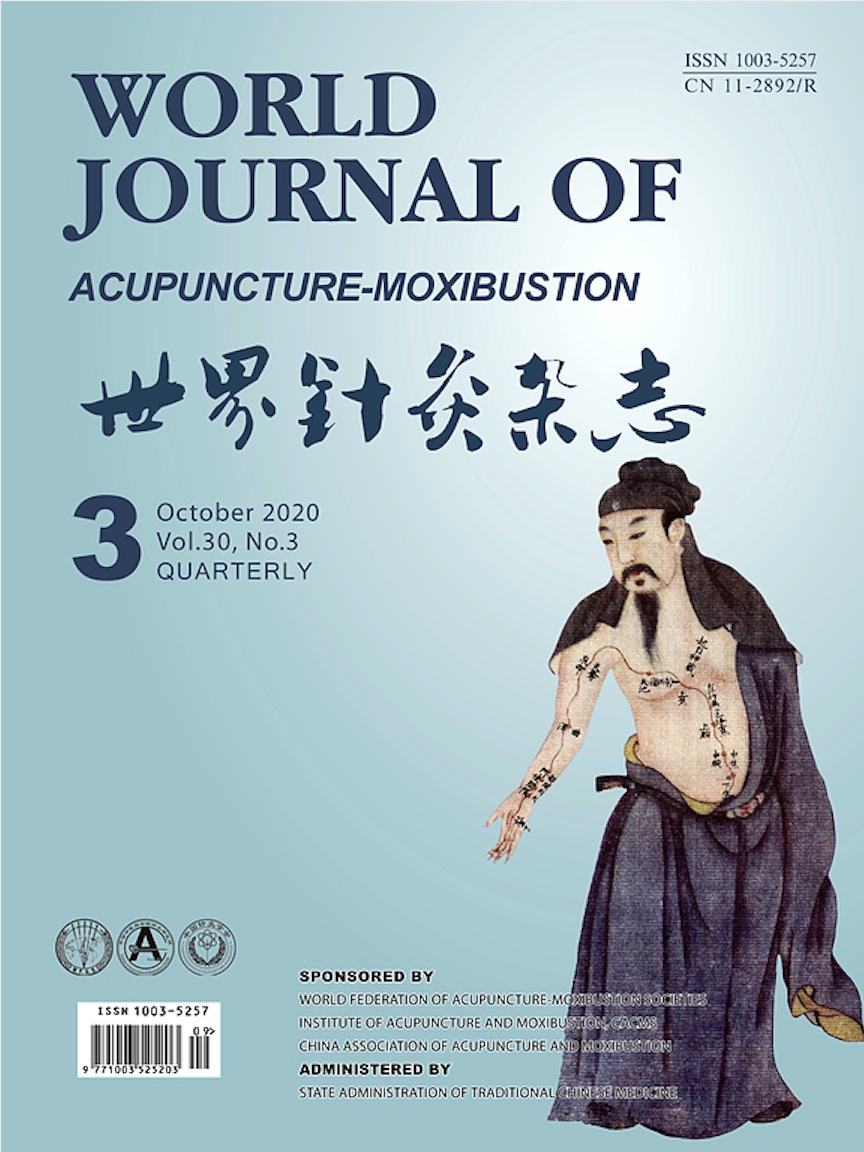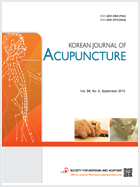Back-Shu Points
How to submit an article:
- Registered users can submit any published journal article that has a unique DOI (Digital Object Identifier) name or link to Research Hub.
- For example, you can paste the full DOI link:
https://doi.org/10.1109/5.771073or just the DOI name:10.1109/5.771073into the field above and click submit. - The person who is first to submit a valid article to Research Hub will forever be credited for it, and every article submission earns you +6 Research Points.
Published research studies are articles that present the findings of original research that has undergone a peer-review process and has been made publicly available in scholarly journals, books or other media.

Anatomical structures and needling method of the back-shu points BL18, BL20, and BL22 related to gastrointestinal organs: A PRISMA-compliant systematic review of acupoints and exploratory mechanism analysis
2022 Oct 28 Medicine Cho Y, Han Y, Kim Y, Han S, Oh K, Chae H, et al.
Systematic Review Digestive HealthAcupuncture covering the depth ranges for BL18, BL20, and BL22 and their targeting of various tissues potentially alleviates sympathetic nerve issues and ischemia with assistance of the diaphragm.

Acupuncture on back-shu points of five zang for chronic fatigue syndrome: A randomized control trial
2018 Dec World Journal of Acupuncture-Moxibustion CHEN S, LIU R, WU B, CHEN S, GUO F, XUE X, et al.
Randomised Controlled Trial Back-Shu Points Chronic Fatigue SyndromeAcupuncture on back-shu points of five zang, significantly improves both the physical and mental fatigue in chronic fatigue syndrome patients, along with enhancing their psychological status.

Study on the Treatment Mechanism of Back-Shu Points for Organ Dysfunction
2016 Sep 27 Korean Journal of Acupuncture Hwang MS
The back-shu points treatments work through the mechanism of the sympathetic nervous reflex. Moreover, segmental acupuncture can reduce tension of the spinal muscles, thereby improving pathological conditions of the sympathetic nervous system.
Review Article Organ Dysfunction Back-Shu Points
The rules of acupoint-selection of acupuncture for polycystic ovary syndrome based on data mining
2016 Sep World Journal of Acupuncture-Moxibustion YU C, KONG L, MA C, SHEN F, YAO GJ, XIONG Y, et al.
Systematic Review Meta-AnalysisAcupuncture's acupoint selection for treating PCOS, identifying top acupoints like Sānyīnjiāo (SP 6) and Guānyuán (CV 4). Findings reveal modern acupuncture's alignment with traditional theory, often targeting abdomen and lower limb points, including front-mu, he-sea, matching, and back-shu points.
Research insights are moderated by the Research Hub team and offer an at-a-glance overview of interesting research findings.

2022 Medicine
Acupuncture covering the depth ranges for BL18, BL20, and BL22 and their targeting of various tissues potentially alleviates sympathetic nerve issues and ischemia with assistance of the diaphragm.
Systematic Review Digestive Health
Anatomical structures and needling method of the back-shu points BL18, BL20, and BL22 related to gastrointestinal organs: A PRISMA-compliant systematic review of acupoints and exploratory mechanism analysis
Cho Y, Han Y, Kim Y, Han S, Oh K, Chae H, et al.

2018 World Journal of Acupuncture-Moxibustion
Acupuncture on back-shu points of five zang, significantly improves both the physical and mental fatigue in chronic fatigue syndrome patients, along with enhancing their psychological status.
Randomised Controlled Trial Chronic Fatigue Syndrome
Acupuncture on back-shu points of five zang for chronic fatigue syndrome: A randomized control trial
CHEN S, LIU R, WU B, CHEN S, GUO F, XUE X, et al.

2016 World Journal of Acupuncture-Moxibustion
Acupuncture's acupoint selection for treating PCOS, identifying top acupoints like Sānyīnjiāo (SP 6) and Guānyuán (CV 4). Findings reveal modern acupuncture's alignment with traditional theory, often targeting abdomen and lower limb points, including front-mu, he-sea, matching, and back-shu points.
Systematic Review
The rules of acupoint-selection of acupuncture for polycystic ovary syndrome based on data mining
YU C, KONG L, MA C, SHEN F, YAO GJ, XIONG Y, et al.
Review Articles
Review articles summarise and critically evaluate the current state of research on a specific topic or field by synthesising multiple primary research studies.

Anatomical structures and needling method of the back-shu points BL18, BL20, and BL22 related to gastrointestinal organs: A PRISMA-compliant systematic review of acupoints and exploratory mechanism analysis
2022 Oct 28 Medicine Cho Y, Han Y, Kim Y, Han S, Oh K, Chae H, et al.
Systematic Review Digestive HealthAcupuncture covering the depth ranges for BL18, BL20, and BL22 and their targeting of various tissues potentially alleviates sympathetic nerve issues and ischemia with assistance of the diaphragm.
Don't know why DOI doesn't work —Adrian Y 14 Sep 2023

Study on the Treatment Mechanism of Back-Shu Points for Organ Dysfunction
2016 Sep 27 Korean Journal of Acupuncture Hwang MS
The back-shu points treatments work through the mechanism of the sympathetic nervous reflex. Moreover, segmental acupuncture can reduce tension of the spinal muscles, thereby improving pathological conditions of the sympathetic nervous system.
Review Article Organ Dysfunction Back-Shu Points
The rules of acupoint-selection of acupuncture for polycystic ovary syndrome based on data mining
2016 Sep World Journal of Acupuncture-Moxibustion YU C, KONG L, MA C, SHEN F, YAO GJ, XIONG Y, et al.
Systematic Review Meta-AnalysisAcupuncture's acupoint selection for treating PCOS, identifying top acupoints like Sānyīnjiāo (SP 6) and Guānyuán (CV 4). Findings reveal modern acupuncture's alignment with traditional theory, often targeting abdomen and lower limb points, including front-mu, he-sea, matching, and back-shu points.
Clinical Trials
Clinical trials are research studies that involve people and are conducted to evaluate the safety and efficacy of new treatments or interventions, such as drugs, medical devices, or behavioural therapies.
Study Protocols
Published study protocols are detailed plans that outline the objectives, methodology, statistical analyses, and organisation of a research study that have been made publicly available for others to review and use as a reference.
Presentation Slides

Systematic Review
Acupuncture covering the depth ranges for BL18, BL20, and BL22 and their targeting of various tissues potentially alleviates sympathetic nerve issues and ischemia with assistance of the diaphragm.
Cho Y, Han Y, Kim Y, Han S, Oh K, Chae H, Hongmin C, Ryu M

Randomised Controlled Trial
Acupuncture on back-shu points of five zang, significantly improves both the physical and mental fatigue in chronic fatigue syndrome patients, along with enhancing their psychological status.
CHEN S, LIU R, WU B, CHEN S, GUO F, XUE X, WANG J

Systematic Review
Acupuncture's acupoint selection for treating PCOS, identifying top acupoints like Sānyīnjiāo (SP 6) and Guānyuán (CV 4). Findings reveal modern acupuncture's alignment with traditional theory, often targeting abdomen and lower limb points, including front-mu, he-sea, matching, and back-shu points.
YU C, KONG L, MA C, SHEN F, YAO GJ, XIONG Y, ZHOU H
Executive Summary
Write an executive summary in the form of a blog article on the topic of "Research into Chinese medicine treatment for Back-Shu Points" summarising the research below and using language that can be easily understood by patients and avoiding medical jargon using a professional and caring tone of voice.
Write an executive summary in the form of a blog article on the topic of "Researched Chinese medicine treatments for Back-Shu Points" summarising the research below in an objective and easy to understand way, and using language that can be easily understood by patients. Group the article into Chinese medicine treatments first, followed by nutrition and other treatments. Avoid using medical jargon and use a professional and caring tone of voice.
Write me a concise but easy to understand executive summary on the topic of "Chinese medicine treatments for Back-Shu Points" based on the following research that I will give you. Your summary should be 2 paragraphs long in Australian English spelling and include references to the studies.
A Systematic Review published in 2022 in the journal Medicine found that Acupuncture covering the depth ranges for BL18, BL20, and BL22 and their targeting of various tissues potentially alleviates sympathetic nerve issues and ischemia with assistance of the diaphragm. Review analyzed 115 articles on needling depth and angle for back-shu acupuncture points in GI diseases. Key findings include the depth range for BL18, BL20, and BL22 points, their targeting of muscles, nerves, and diaphragmatic tissues, and the potential for acupuncture to alleviate sympathetic nerve overexcitability and ischemia while emphasizing the diaphragm's role in digestive function.
A Randomised Controlled Trial published in 2018 in the journal World Journal of Acupuncture-Moxibustion found that Acupuncture on back-shu points of five zang, significantly improves both the physical and mental fatigue in chronic fatigue syndrome patients, along with enhancing their psychological status. In this study, sixty patients divided into a treatment group and a control group. The treatment group received acupuncture on the back-shu points of five zang organs. Techniques used included perpendicular and oblique needling, lifting-thrusting, and twisting-twirling, each acupoint being attended for 10 seconds. In contrast, the control group received the treatment outward of these points without seeking deqi, a sensation linked to effective needling, and with no manipulation. Both groups received treatments twice a week, each lasting twenty minutes, and to a total of eight treatments. The study's results showed that there was a higher effective treatment rate seen in the group who received acupuncture on back-shu points than the control group. Physical and mental fatigue scores, assessed using Fatigue Scale-14, were significantly reduced post-treatment in the treatment group. Moreover, the Symptom Check-List 90, used to measure the patient's psychological status, showed notable improvement in the treatment group, demonstrating that the acupuncture approach used in the treatment group improved not just physical and mental fatigue but also the patients' psychological state. While the treatment rendered a positive impact on the control group too, the outcome was more pronounced in the treatment group.
A Systematic Review published in 2016 in the journal World Journal of Acupuncture-Moxibustion found that Acupuncture's acupoint selection for treating PCOS, identifying top acupoints like Sānyīnjiāo (SP 6) and Guānyuán (CV 4). Findings reveal modern acupuncture's alignment with traditional theory, often targeting abdomen and lower limb points, including front-mu, he-sea, matching, and back-shu points. The study's objective was to analyze acupuncture's acupoint selection patterns for treating polycystic ovary syndrome (PCOS). Acupoint information was gathered from clinical trials retrieved from multiple databases, revealing the most frequently utilized acupoints, including Sānyīnjiāo (SP 6), Guānyuán (CV 4), Zhōngjí (CV 3), and others. The study concludes that modern acupuncture for PCOS is rooted in traditional Chinese acupuncture theory, frequently targeting acupoints along the abdomen and lower limbs, with a preference for front-mu points, he-sea points, matching points, and back-shu points.
Moderation Tools
Topic
Sign In
Users not signed in are limited to viewing the 5 most recent items of content.
Don't know why DOI doesn't work —Adrian Y 14 Sep 2023